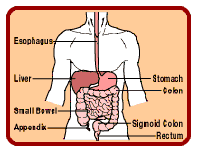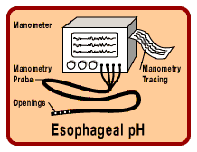
The esophagus is the tube that carries food and liquid from the throat to the stomach. Although it seems like a simple organ, the esophagus is not a rigid tube. The wall of the esophagus contains muscle that rhythmically contracts whenever a person swallows. This contraction occurs as a sweeping wave (peristalsis) carrying food down the esophagus. It literally strips the food or liquid from the throat to the stomach.
Another important part of the esophagus is the lower valve muscle (lower esophageal sphincter, or LES). This is a specialized muscle that remains closed most of the time, only opening when swallowed food or liquid is moved down the esophagus or when a person belches or vomits. This muscle protects the lower esophagus from caustic stomach acid and bile. These substances, of course, cause the discomfort of heartburn and in time can lead to damage and scarring in the esophagus. At times, everyone has heartburn, especially after a large or fatty meal.
Manometry is the recording of muscle pressures within an organ. So esophageal manometry measures the pressure within the esophagus. It can evaluate the action of the stripping muscle waves in the main portion of the esophagus as well as the muscle valve at the end of it.
Manometer Equipment

The equipment for manometry consists of thin tubing with openings at various locations.
When this tube is positioned in the esophagus, these openings sense the pressure in various parts of the esophagus. As the esophagus squeezes on the tube, these pressures are transmitted to a computer analyzer that records the pressures on moving graph paper. It is much like an electrocardiogram. The physician can evaluate these wave patterns to determine if they are normal or abnormal.
